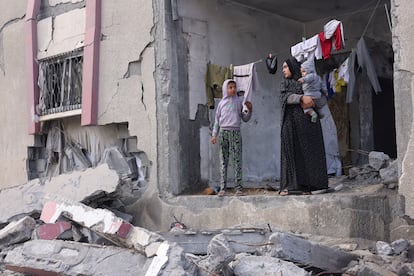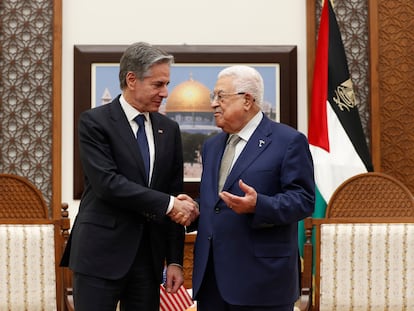Biden expects Israel and Hamas to agree on a ceasefire in Gaza in the coming days
In Qatar, the Islamist group is considering a proposal for a six-week truce to exchange 40 Israeli hostages for the release of 400 Palestinian prisoners and an increase in humanitarian aid to the Gaza Strip

For the first time, U.S. President Joe Biden put a date on the possibility of a second ceasefire in Gaza: “My hope is by next Monday, we’ll have a ceasefire.” The United States is one of the countries mediating the negotiations that have gained momentum in recent days. Those talks produced a proposal that Hamas is now considering: a six week-long ceasefire to exchange 40 (of the more than 130) hostages in the Gaza Strip for the release of 400 Palestinian prisoners and an increase in humanitarian aid for a starving Gaza. Majed al Ansari, the spokesman for the Qatari Foreign Ministry, where the dialogue was taking place on Tuesday, said he was “optimistic.” Israel and Hamas are considerably less so.
“My National Security Advisor [Jake Sullivan] tells me that we’re close. We’re close. It’s not done yet,” Biden told a group of journalists in New York on Monday. The statements confirm that the parties are gradually narrowing their differences on a second ceasefire, after the week-long cessation of hostilities in November. That contrasts with the public statements of the two sides’ leaders. In the Israeli case, those comments have much to do with gearing up for the elections that are likely to be held later this year. Earlier this month, Israeli Prime Minister Benjamin Netanyahu called it “delusional” for Hamas to demand a 135-day-long ceasefire, the release of up to 1,500 Palestinian prisoners and the indirect negotiation of a definitive end to the war in exchange for returning all hostages. Two weeks ago, in fact, he ordered the negotiating delegation to stay in the country because Hamas kept up its demands.
Since then, both have blamed the other side for the stalemate. On Sunday, Hamas leader Ismail Haniyeh claimed the “seriousness and a lot of flexibility” they are showing and lamented that Israel is “dragging its feet.” For his part, Netanyahu held the Islamists responsible and pointed out that they live “on another planet” with their demands. Indeed, this Monday, he issued a statement in which he announced the submission of a military plan to evacuate the population of Rafah, in the south of the Strip, in the face of the invasion, which seems aimed more at pressuring Hamas to make concessions than at informing the public.
Away from the microphones, however, last Friday a meeting of the Israeli side with the three mediators (Qatar, Egypt and the United States) in Paris produced the proposal now being discussed by Hamas. It consists of a six-week ceasefire and the release of 40 civilian hostages: women, minors under the age of 19, people over 50 years old and the sick. In return, Israel would free 400 Palestinian prisoners (a ratio three times higher than in the first swap, but well below previous ones), allow more humanitarian aid to enter Gaza, relocate troops and permit residents of the evacuated areas who are not of fighting age return to see the state of their homes, Reuters reports. An official Israeli source told Channel 12 television that he expects Hamas to reject the proposal and spoke only of “slow progress,” while an Islamist official said that “many positions need to be brought closer together.”
In any case, the current format of the dialogue — known as proximity talks — only tends to be applied when there are broad areas of agreement with more progress on the details. Israeli and Hamas representatives do not meet directly, but they are in the same city and meet separately with the mediators, which speeds up the process.
The importance of Ramadan
One element driving the current dialogue is the approach of the Muslim holy month of Ramadan, when tensions in the Middle East tend to flare up. This year, it begins on March 10. Last year, there was an escalation of violence, after the police violently entered the Al Aqsa Mosque in Jerusalem twice. This year, the feeling is that it could represent a perfect storm for Palestinians to erupt from all the pent-up tension stemming from the combined 30,000 deaths in Gaza, an unprecedented number of fatalities from settler raids and attacks in the West Bank, and the loss of economic livelihoods for tens of thousands of construction and agricultural day laborers, whose work permits in Israel and Jewish settlements have been frozen since Hamas’s massive October 7 attack.
That is even more of a concern since, according to Israeli media, Netanyahu supports the proposal of his head of National Security, the ultra-right-wing Itamar Ben Gvir, to limit access to the Dome of the Rock to Muslim Israelis, about 20% of the population. No official decision has yet been made. Ramadan is observed for a month, so the United States is pushing for a ceasefire and prisoner release to take place during that time.
Washington first wants to establish a temporary cessation of hostilities and then negotiate a definitive one and convince Israel not to resume bombing. “There is an understanding that the month-and-a-half pause would be used not only to regulate life in Gaza, but also for talks on a comprehensive agreement, which the United States, Saudi Arabia and Israel want,” Israeli sources familiar with the negotiations told the Maariv daily Tuesday. These sources spoke of a permanent pact to end the war in which Hamas would cease to control Gaza, its leaders and commanders would be exiled to another country and members of the militia would hand over their weapons. The resignation of the Palestinian Authority government on the eve of the war paves the way for the formation of an executive of technocrats that could resume control of Gaza, which has been exclusively in the hands of Hamas since 2007. This is what the United States wants but Israel rejects.
Publicly, Netanyahu insists that no ceasefire — regardless of how long — will mean the end of the war; rather, it represents a pause on the path to “total victory.” That means invading Rafah, after the forced evacuation of more than a million Palestinians displaced there. On Sunday, he ventured that the “phase of intense combat” will last “a few weeks, not months,” once the troops enter Rafah.
Sign up for our weekly newsletter to get more English-language news coverage from EL PAÍS USA Edition
Tu suscripción se está usando en otro dispositivo
¿Quieres añadir otro usuario a tu suscripción?
Si continúas leyendo en este dispositivo, no se podrá leer en el otro.
FlechaTu suscripción se está usando en otro dispositivo y solo puedes acceder a EL PAÍS desde un dispositivo a la vez.
Si quieres compartir tu cuenta, cambia tu suscripción a la modalidad Premium, así podrás añadir otro usuario. Cada uno accederá con su propia cuenta de email, lo que os permitirá personalizar vuestra experiencia en EL PAÍS.
¿Tienes una suscripción de empresa? Accede aquí para contratar más cuentas.
En el caso de no saber quién está usando tu cuenta, te recomendamos cambiar tu contraseña aquí.
Si decides continuar compartiendo tu cuenta, este mensaje se mostrará en tu dispositivo y en el de la otra persona que está usando tu cuenta de forma indefinida, afectando a tu experiencia de lectura. Puedes consultar aquí los términos y condiciones de la suscripción digital.
More information
Archived In
Últimas noticias
Most viewed
- Sinaloa Cartel war is taking its toll on Los Chapitos
- Oona Chaplin: ‘I told James Cameron that I was living in a treehouse and starting a permaculture project with a friend’
- Reinhard Genzel, Nobel laureate in physics: ‘One-minute videos will never give you the truth’
- Why the price of coffee has skyrocketed: from Brazilian plantations to specialty coffee houses
- Silver prices are going crazy: This is what’s fueling the rally











































